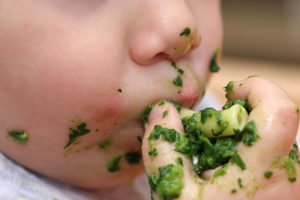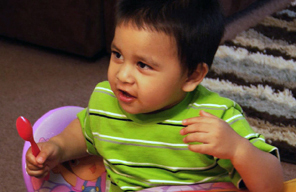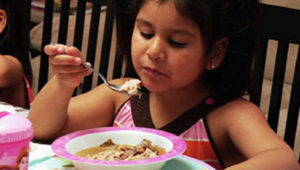Feeding At Every Age
Eating is a skill that needs to be learned. Parents and caregivers play an important role in teaching children at every stage the skills necessary to eat in a way that is right for them. This section will give you helpful ideas for how to follow the Satter Division of Responsibility in Feeding at every age and stage so your child can grow up to be a competent eater.
Feeding the Infant (Birth to 6 months):
ADULT’S JOB: determine what of feeding (breast milk, formula or combination).
CHILD’S JOB: determine when, where, whether and how much of eating (including how fast and how frequently).
 Newborns come out of a quiet, dark place into a world full of sights, sounds and commotion. Babies love being with their primary caregiver, and they begin learning what eating is all about.
Newborns come out of a quiet, dark place into a world full of sights, sounds and commotion. Babies love being with their primary caregiver, and they begin learning what eating is all about.
Keep feedings smooth and steady.
Pay attention to your baby’s cues, feeding them when they are ready to eat. Stop feeding when they show you they are finished with eating. You will notice they will relax, slow down and stop.
Your baby knows how much to eat.
When you maintain the Division of Responsibility, your baby will eat as much as they need to grow in the way that is right for them. Let your baby eat in their own way – fast or slow, steady or start-and-stop, a lot or a little.
Start solid foods when your baby is ready.
The decision to introduce solid foods should be based on what your baby can do, not by how old they are. When he can sit up, see food coming, and open up for it, he may be ready for you to begin introducing semi-solid foods in addition to breastfeeding or bottle-feeding. That is around 6 months for most babies.
Feeding the Older Baby (6 – 12 Months):
Prior to starting solid foods:
ADULT’S JOB: determine the what of feeding (breast milk, formula or combination).
CHILD’S JOB: determine when, where, whether and how much of eating (including how fast and how frequently).
After starting solid foods:
ADULT’S JOB: determine the what, when and where of feeding
CHILD’S JOB: determine whether to eat and how much.
Gradually transition to solid foods.
When your child is ready, you can guide the transition from bottle or breast feeding to semi-solid foods, then to thicker and lumpier foods, and finally to finger foods at your family meals.
Each baby starts solids differently.
One baby will accept solid foods from the start, quickly learn to close their lips over the spoon and swallow, accept thicker, lumpier food, and be ready by 7-10 months old to finger-feed themselves modified family food at family meals. Another child may cautiously accept solids but needs to be introduced gradually to a variety of tastes and textures and may not eat family foods until they are 2 or 3 years old. Another may take to the spoon readily and demand to feed themselves even when they can’t! Still another isn’t at all interested in the spoon, and waits to eat solid foods until they can finger-feed themselves. Let your child do it their way.
How to introduce solid foods (provided the child is willing):
- Sit your child securely in a high chair.
- Hold the spoon a few inches in front of their mouth and wait to see what they do.
- Let them eat or not eat, eat a little or a lot, fast or slow.
- Stop the feeding when they are done opening, swallowing, smearing, dropping, banging.
- Give them plenty of chances to learn, have fun, and keep it casual.
Get started with family meals.
The point is not to try and get food into your baby. They are getting plenty of nourishment from breast milk or formula. The point is to gradually introduce them to the notion of eating food in a different way. If you get pushy you will spoil the fun for both of you! Your baby will gradually eat more regularly and at longer intervals, so at this stage feeding times are partly on demand and partly on a schedule that you determine. Feeding them will go best if you bring the child to the table when you eat and get started now with family meals.
Feeding the Almost-Toddler (7 – 15 Months):
During this stage is when you begin to establish a routine of regular meals and snacks.
ADULT’S JOB: determine what, when and where of feeding.
CHILD’S JOB: determine how much and whether of eating.
 Include your child in family meals.
Include your child in family meals.
Offer your child safe foods that are easy to pick up, chew and swallow. Give them about a tablespoon of each food. Offer breastmilk or formula in a cup instead of a bottle. You can switch to whole milk when they are eating family food at mealtime and at least a year old. Let them decide to eat or not eat from the foods you offer. Let them have more if they want. Give them lots of chances to explore and try a new food and learn to like it. Let them eat their own way, using their fingers or a spoon, a lot or a little, fast or slow, and in any order – even if they eat dessert first. Let them get down when they are finished – even after just a few minutes.
Why only water between meals?
Children who graze on food and sweetened beverages (juice/milk) will not be hungry or ready to eat at mealtime. As a result, these children arrive at meals uninterested in eating or learning to eat family food. This is not because of the food itself but because of the lack of structure. Only offering water to your child between regular meal and snack times allows the child to arrive at eating times hungry and ready to eat, and helps maintain structure.
Allow your child to start feeding themselves.
The child just getting started with finger-feeding cares deeply about feeding themselves and is enthusiastic about eating almost everything you put before them. The problem is that it happens so fast. One day they happily let you feed them. The very next day – or the very next meal – they refuse the spoon, grab at it, and put up a fuss when you try to feed them. Many parents become alarmed and start to force or play games to get their child to eat. Resist this urge since doing this is likely going to make their eating worse, not better, and you will introduce feeding struggles that can go on for years. Instead, let them feed themselves. Get started with family meals, if you aren’t having them already, and don’t just feed them, eat along with them.
Sit-down snacks
At the almost-toddler stage, you continue to support the transition from demand feeding to more structured feeding by offering your child sit-down snacks roughly every 2-3 hours between meals. That lets them arrive at mealtime hungry (but not starved) and therefore able to behave at meals. While they are likely to love drinking and eating on-the-go, this does not allow them to learn to eat the food you eat since getting special food at special times is more to their liking. Offer any breast milk or formula as a structured, sit-down snack. Don’t offer anything else between meal or snack times except water.
Feeding the Toddler (1 – 3 Years):
ADULT’S JOB: determine what, when and where of feeding.
CHILD’S JOB: determine whether and how much of eating.
 Your toddler’s eating can suddenly become cautious, erratic, picky, and fickle. Many times, they will only eat a few tastes, swallows, finger-fulls, or bites. Other times, they will eat more than you can imagine. Do not try in any way to get your child to eat more or less food. Instead, let them decide what and how much to eat.
Your toddler’s eating can suddenly become cautious, erratic, picky, and fickle. Many times, they will only eat a few tastes, swallows, finger-fulls, or bites. Other times, they will eat more than you can imagine. Do not try in any way to get your child to eat more or less food. Instead, let them decide what and how much to eat.
Get into the habit of having regular, reliable meals and sit-down snacks.
Start by having 3 meals a day at set times and eat along with your child. Offer them sit-down snacks every 2 to 3 hours between meals. Offer foods you choose at sit-down meals and snacks, at regular and reliable times. At these meals and snacks let your child decide how much, how little, and even whether to eat from the foods you have put on the table. Let them eat food in any order, even if they eat dessert first. Keep yourself calm by understanding that erratic eating behavior is normal at this stage. Remind your child that once they leave the table that indicates to you that they are finished eating. Teach them to play quietly while you finish eating.
Avoid using food to soothe emotional distress.
Your toddler is at high risk for learning to use food for emotional reasons. Toddlers are active, unceasing in their demands and prone to get upset. Resist the temptation to use food to calm tantrums. Instead, stick to scheduled feedings and sort out whether your child is hungry or sad, full or tired. Give attention, appropriate discipline, hugs or naps depending on what they need. Say no when they beg for food or sweetened beverages between meal and snack times, and offer water only.
Maintain the quality of your feeding relationship.
Instead of focusing on what your child eats, focus on how your child feels and behaves at family meals. They may be skeptical even of food they have eaten enthusiastically before. Do not become a short-order cook or limit the menu to foods they readily accept. Instead, decide menus by including 1-2 foods the child generally eats along with other mealtime food.
Feeding the Preschooler (3 – 6 Years):
ADULT’S JOB: determine what, when and where of feeding.
CHILD’S JOB: determine whether and how much of eating.
 Trust the preschooler to manage their own eating.
Trust the preschooler to manage their own eating.
Compared with feeding a toddler, feeding a preschooler is easy. Your preschooler is playful and quirky and wants to please you in all ways – including eating. In some ways, that makes feeding harder. If you pressure your preschooler to eat more, less, or different foods, and they are compliant, they will stop being able to self-regulate as they are consistently being told to eat more or less than what they are actually hungry for.
How to include sweets and desserts:
Giving children unlimited access to desserts at mealtimes does not support them in learning to like a variety of other mealtime foods. We recommend serving up dessert with the meal so the child can choose to eat it at any time. After that they will have the option of filling up on the other foods offered. You can offer these same foods at the occasional snack times and give children the option to eat as much as they want so they can learn to manage these foods appropriately.
If they are not compliant, they will fight back and every feeding time will become a battleground full of power struggles. In the same way, if you keep after them about table manners when it is still perfectly natural for them to use their fingers along with silverware, they can feel bad about eating. The best thing is do is throw out any agenda, and instead focus on making meals with food you enjoy to eat with your child.
Maintain regular meals and sit-down snacks.
Have 3 meals a day at set times and sit-down snacks at more-or-less set times. Say no to grazing on food and caloric beverages between times and instead offer water. Sit down and eat with your child. Make mealtimes pleasant by engaging in conversation with your child. Be family-friendly in your meal-planning by putting together meals that allow everyone to be successful. Let them serve themselves and eat their way – fast or slow, as much or as little as they want, eating all the foods available or selecting to eat just 1 or 2 foods from what is offered. Let them eat in any order, even if they eat dessert first. Let them have more of any food (except dessert), even if they have not finished their plate. Excuse the child from mealtime when they are done.
Feeding the School-age Child (6 – 12 Years):
ADULT’S JOB: determine what, when and where of feeding.
CHILD’S JOB: determine whether and how much of eating.
 Support your child as they learn and grow.
Support your child as they learn and grow.
Your school-aged child wants to master all things – including eating, but they are still a child, and they are entitled to be free from worry about eating and weight. Children seem independent, but they depend on you to provide leadership with setting menus and continue to need the structure and support of regular family meals and structured snacks.
Considerations for feeding your school-aged child:
- Arrange for your child to have 3 family-friendly meals a day at set times.
- Let them eat fast or slow, a lot or a little, some of everything or just 1 or 2 foods.
- Let them eat in any order, even if they eat dessert first.
- Let them have more of any food, even if they haven’t finished their plate.
- Only offer water between meals and snacks. Grazing on food and sweetened beverages (juice/milk) means the child may not have enough time to be hungry or ready to eat.
After-school snacking.
Plan to have a sit-down snack right after school at the table. No munching along with homework or in front of the TV. After they learn to go by the snacking rules, let your older school-age child choose their own snack, even if they select a food higher in fat or sugar.
Feeding the Adolescent (12 – 17 Years):
ADULT’S JOB: determine what, when and where of feeding.
CHILD’S JOB: determine whether and how much of eating.
Protect family mealtimes.
Adolescents who have family meals do better in all ways. They also do better nutritionally after they leave home. Despite them acting like it doesn’t matter, your adolescent continues to depend on you to maintain the structure of family meals. They will participate in family meals when you make meals a priority. Keep mealtimes pleasant and use them as a time to connect with your child. With feeding as with all other things, your task is to find the middle ground between being overly controlling on the one hand and throwing away all controls on the other.
Teach them to take responsibility for eating meals and snacks.
Doing your jobs with feeding and letting your child do theirs with eating guides you in knowing when to take the leadership with feeding and when to let go. Expect your child to manage their schedule and snacking so they can arrive at family meals on time and hungry. Teach them to take responsibility for eating 3 meals a day with a snack right after school.
Eating away from home.
When it comes to eating food away from home let your child make their own decisions about what to eat, how much to eat, and how to get what they need. Discuss food-management strategies with them, to help them consider what works and what doesn’t. Build your child’s food-management skills including meal planning, food preparation, shopping, storage, and sanitation to prepare them for when they leave home someday.
